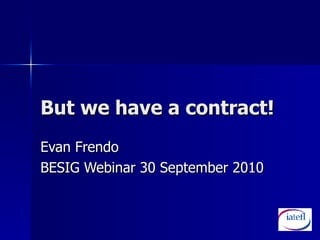But we have a contract!
•
0 likes•218 views
Evan Frendo: Many of the people we teach have to deal with contracts in English, and the language of contracts is a common topic in business English teaching. The problem is that teaching the language is often not enough - different cultures have different perspectives on the role and function of contracts, and our learners need to be able to deal with this aspect too. In this brief talk I will discuss some of these perspectives, and suggest ways you can incorporate them into language training.
Report
Share
Report
Share

Recommended
More Related Content
Viewers also liked
Viewers also liked (14)
English Language Needs of Business, Economics & Accounting Students

English Language Needs of Business, Economics & Accounting Students
#BESIGBonn 2014 Teach like ted teaser - Paula Mulanovic

#BESIGBonn 2014 Teach like ted teaser - Paula Mulanovic
Presentations across cultures - How are they different?

Presentations across cultures - How are they different?
Assessing Intercultural Business Communicative Competence

Assessing Intercultural Business Communicative Competence
Using e-feedback in large classes in a business writing course

Using e-feedback in large classes in a business writing course
Polishing presentations by JoAnn Salvisberg at IATEFL BESIG TEASIG PCE 2015

Polishing presentations by JoAnn Salvisberg at IATEFL BESIG TEASIG PCE 2015
Similar to But we have a contract!
Similar to But we have a contract! (20)
From [email protected]Re Academic Misconduct Antoinette Har.docx![From [email protected]Re Academic Misconduct Antoinette Har.docx](data:image/gif;base64,R0lGODlhAQABAIAAAAAAAP///yH5BAEAAAAALAAAAAABAAEAAAIBRAA7)
![From [email protected]Re Academic Misconduct Antoinette Har.docx](data:image/gif;base64,R0lGODlhAQABAIAAAAAAAP///yH5BAEAAAAALAAAAAABAAEAAAIBRAA7)
From [email protected]Re Academic Misconduct Antoinette Har.docx
Chapter SevenNegotiation and ConflictChristopher Robbins.docx

Chapter SevenNegotiation and ConflictChristopher Robbins.docx
Getting Down To The Details: Contract Basics for Non-Lawyers

Getting Down To The Details: Contract Basics for Non-Lawyers
TextSeaquist, G. (2015). Employee and labor relations A practic.docx

TextSeaquist, G. (2015). Employee and labor relations A practic.docx
1.Caitlin RosicaWednesdayApr 15 at 542amManage Discussion Ent.docx

1.Caitlin RosicaWednesdayApr 15 at 542amManage Discussion Ent.docx
Morton Fraser/Nidos - Legal Issues of Partnerships in International Development

Morton Fraser/Nidos - Legal Issues of Partnerships in International Development
DUE ASAP THANKS(NO special format or pages jsut replis or feedbacks .docx

DUE ASAP THANKS(NO special format or pages jsut replis or feedbacks .docx
How to negociate #contracts as a #startup & do it like a boss 

How to negociate #contracts as a #startup & do it like a boss
But we have a contract!
- 1. But we have a contract! Evan Frendo BESIG Webinar 30 September 2010
- 3. Some quotes I ’ m sorry. Someone else signed the contract. We have to re-negotiate. Let’s start anyway. The contract is in the post. They are obsessed with paper. A piece of paper is meaningless – people count, not papers!
- 4. Not flexible enough. They sign, and then they ignore it. They just change specifications, materials, delivery dates without telling anyone. Anything to save money. They don ’ t care that our customers won ’ t accept their changes. It ’ s not their problem. I am happy to work without contracts, or at least I can live without them. The problem is that my boss can ’ t.
- 5. Are they honest? Not sure. They have different rules for what is right or wrong. They have the wrong priorities. If we take a lawyer with us he just advises us not to do business with such people. This doesn ’ t solve the problem!
- 9. Not just a text (Bhatia, 2010, p.34)
- 10. Market pressure There ’ s never enough time to really get to know your business partner. Long term relationships don ’ t exist in the real world. It ’ s about money and profit, pure and simple. Everyone is under so much pressure from their own customers. Teams change so fast. This is done on purpose, so that suppliers and buyers don ’ t form personal relationships.
